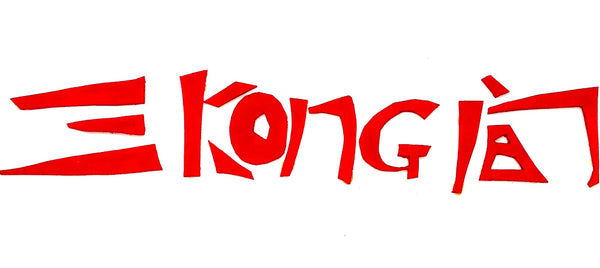Back to Art in the Fields: Xu Bin’s Creative Experiment - Part I
The four installation artworks by Xu Bin seamlessly blend natural materials with sleek, modern industrial elements. These creations delve into the impact of industrialization and urbanization on the traditional rural landscape and way of life. Through his work, Xu Bin illuminates how these transformative processes have affected the countryside, while also demonstrating that a harmonious balance between industrial progress and the natural environment is achievable.
After the renovation of Xu Bin's old house, a large piece of semi-dry cement was left at the site by the workers. Its uneven surface, reminiscent of rural wasteland, inspired Xu Bin. He applied earthy red acrylic paint to the cement, enhancing its resemblance to soil, and then splattered thick blue acrylic paint to create a network-like pattern, evoking the image of earth's fissures. While the cement was still malleable, he embedded three stainless steel tubes of varying lengths into it, resembling columns. The juxtaposition of the modern stainless steel with the rustic cement symbolized the impact of urbanization on ancient rural life. Xu Bin placed this work on the side of a dirt road in the countryside.
In this installation art piece, Xu Bin uses an old wooden plank to symbolize the earth. On this plank, he meticulously arranges small wooden stakes of varying sizes, with some densely packed and others more sparsely placed, representing a vibrant forest. Two transparent glass flasks are mounted on small wooden stakes painted blue and adorned with orange nails, symbolizing sophisticated modern architecture. Through Xu Bin's ingenious design, he seamlessly integrates refined industrial materials—glass flasks—with natural elements—wooden stakes and planks. His work convincingly demonstrates that industrialization and urbanization can indeed coexist harmoniously with the natural environment. The artwork was placed on a blue painted wooden table and displayed in an open space at the corner of the village.
This installation artwork presents a profound exploration of the relationship between nature and modernity. Xu Bin nails two old wooden planks together, forming a right angle. The vertical plank is partially painted a blue-gray color on its right side, with two iron nails at the top, symbolizing the intersection of the old and the new. Additionally, this vertical plank features two delicate, transparent glass flasks, creating a modern architectural structure.
The horizontal plank represents the ground, with its left side painted gold to symbolize the richness and fertility of the earth. This juxtaposition of old wood, industrial iron nails, and refined glass flasks signifies the blend of traditional and contemporary elements.
Through this artwork, Xu Bin highlights the coexistence and potential harmony between industrialization and the natural environment. The gold-painted section of the plank emphasizes the enduring value and vitality of the natural world, even as modern structures rise. This piece invites viewers to reflect on how progress and tradition can be integrated, underscoring the importance of finding balance between development and nature. The artwork was placed on a blue painted wooden table and displayed in an open space at the corner of the village.
Xu Bin's installation artwork, placed on a concrete ground next to a melon shed, embodies a unique dialogue between the organic and the man-made. Upon first sight of the old piece of wood, Xu Bin was struck by its inherent semblance to modern architecture. One end of the wood is cut off, leaving behind an elegant platform, a form that Xu Bin saw as nearly complete.
To enhance this natural form, he added two elliptical wooden blocks and painted them orange. These additions resemble two protruding sunshades, merging functional design with artistic expression.
The artwork’s placement beside the melon shed emphasizes its connection to the rural environment, while its modern architectural elements highlight the intersection of tradition and innovation. Xu Bin’s vision transforms a simple piece of old wood into a representation of contemporary structures, suggesting that even the most humble materials can inspire sophisticated designs. This piece encourages viewers to appreciate the beauty in everyday objects and to recognize the potential for harmony between natural and industrial elements.
Next Reading Art in the Fields: Xu Bin’s Creative Experiment - Part III








